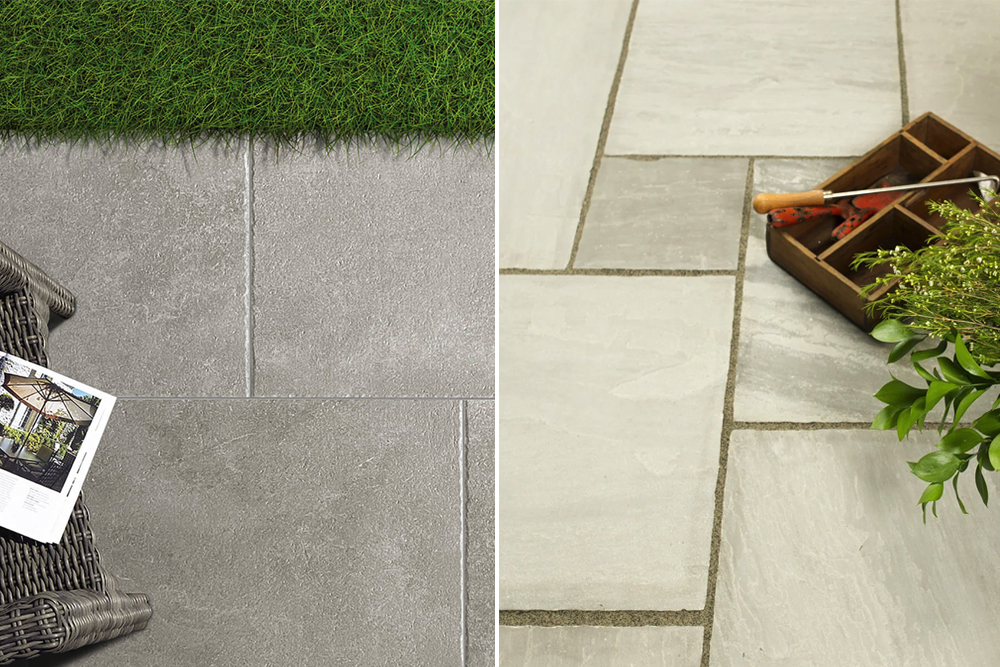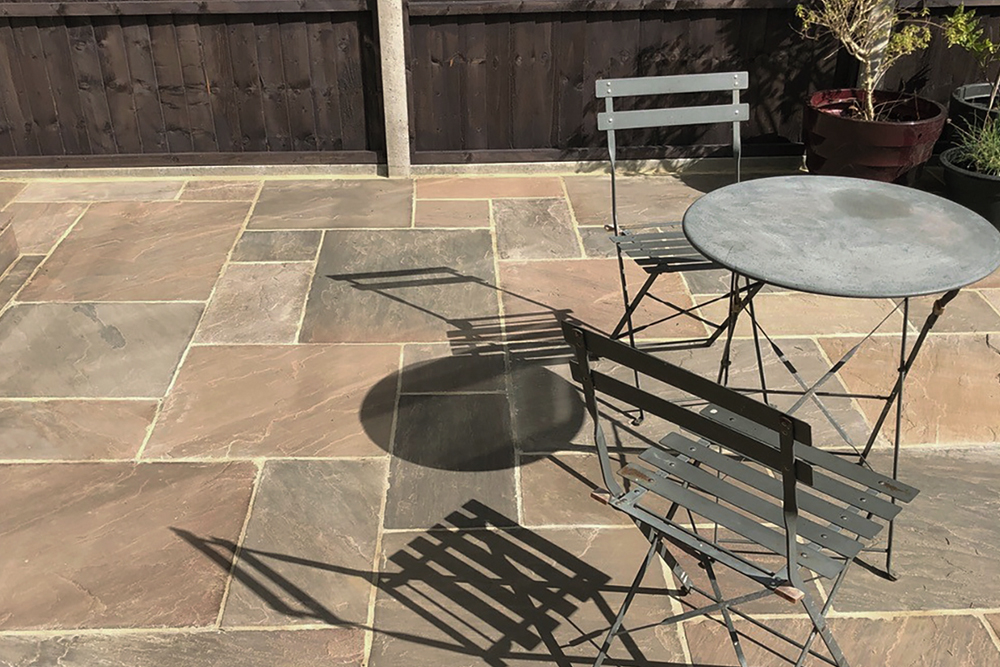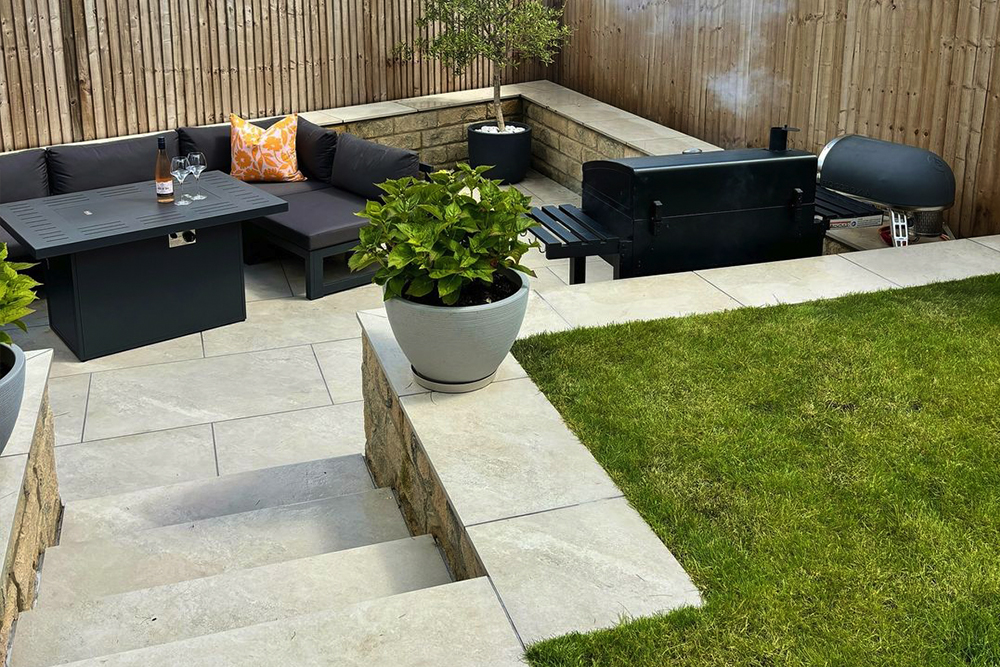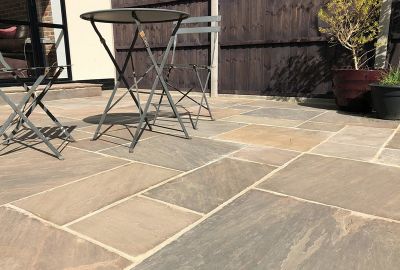Big or small, when it comes to redesigning your garden, few changes can have more of an impact on the space around them than an updated patio, drive, or pathway made from outdoor tiling.
An iconic feature of the British garden scene for decades, a good set of outdoor tiles can do wonders to breathe new life into a tired space.
Of course, when it comes to choosing which outdoor tile material to choose, you’ll may find yourself stuck between two options: porcelain or sandstone paving slabs.
Both excellent choices, and each offering unique benefits for various garden styles, choosing between porcelain vs sandstone paving might seem challenging. However, understanding the distinct advantages of each material can simplify your decision.
Keep reading to learn the key differences between porcelain vs sandstone, so you can pick the right tiling material to suit your garden, starting with what makes porcelain and sandstone physically different.

Left: Charterhouse Grigio Antiqued Porcelain, Right: Classic Silver Grey Sandstone
What are porcelain slabs?
Unlike genuine stone tiles, porcelain slabs are an entirely man-made product, meaning they don’t occur naturally. Instead, porcelain paving slabs are made from a mixture of sand, clay, and other minerals and materials that are then heated together in slab moulds within a kiln at super-high temperatures.
As a result, what you’re left with is an incredibly dense and durable slab of solid material that is perfectly suited for use outdoors, withstanding exposure to the elements.
What are sandstone slabs?
Unlike porcelain tiles, sandstone paving slabs are naturally occurring, thanks to literally millions of years of rock formation. Sandstone, in particular, is often found in India and other warm countries, where the warmer climate creates a very hard-wearing material that is ideal for use in tiling.

Classic Autumn Umber Sandstone
What is the difference between sandstone and porcelain slabs?
So, we now know what the physical difference between sandstone and porcelain slabs is, but what about all the other qualities associated with a set of porcelain vs sandstone pavers?
Aesthetic
First things first, how does sandstone vs porcelain paving compare when examined on an aesthetic level? Is one better-suited for a particular décor than the other or are they both as versatile?
Porcelain
Porcelain paving is incredibly versatile thanks in large part to the way it’s made. With modern, state-of-the-art manufacturing and printing processes, porcelain can be created to mimic a variety of different surfaces, such as marble, limestone, and yes, sandstone, as well as many other designs, enabling you to create a space that perfectly matches your desired aesthetic.
Sandstone
For those seeking a more traditional, rustic aesthetic, then your choice should be to go with natural sandstone paving. After all, sandstone is one of the oldest materials used for outdoor tiling, making it ideal if you want to recreate that classic patio look from a range of light grey colours to shades of deep reds.
Durability
Perhaps the most important factor when it comes to assessing the qualities of outdoor tiles, you’ll no doubt be glad to hear that both sandstone and porcelain are phenomenally tough materials.
Porcelain
As we’ve already mentioned, porcelain is incredibly hard-wearing and dense thanks to the way it’s made, giving it great protection against the elements. Good quality, porcelain is waterproof, non-porous, and somewhat resilient against mould and lichens, making it the kind of material that will last you for years to come.
Sandstone
Sandstone, while being naturally very strong and able to rival and even surpass some types of porcelain in terms of physical strength, has a more porous surface than porcelain, which often makes it more susceptible to the impact of the weather if not cared for properly and sealed regularly.
Maintenance
The ease with which you can care for and look after your new outdoor tiling is always a bonus. After all, the last thing you want to be doing is regularly having to pressure-wash your patio all summer.
Porcelain
When it comes to porcelain vs sandstone, porcelain once again has the edge in this area thanks to its method of construction. Being sealed against moisture and dirt as part of the production process, porcelain tends to require little more than a brush and a hose to clean away debris.
Sandstone
Alternatively, while sandstone is by no means difficult to clean, you’re far more likely to get a build-up of stains and mould on your tiles if they’re not cleaned regularly. Of course, you can avoid this by sealing your sandstone during installation, however bear in mind this seal is not permanent, and does require regular reapplication.
Price
Last, but not least, we come to price. A defining factor when it comes to all forms of renovation and redesign decisions, making sure you can afford the changes you want to make is vital, so you don’t go over budget.
Porcelain
One interesting thing of note about porcelain is that, while it can sometimes be more expensive initially, it may actually save you money in the long term thanks to its low-maintenance properties.
Sandstone
When weighing up porcelain or sandstone paving by price, sandstone appears to be the winner in this area. Its long years of use and utterly timeless style make it a smart investment. However, be sure to factor in the cost of sealants and specialist cleaners to keep them in pristine condition.

Landstone White Outdoor Porcelain
Browse our porcelain and sandstone tiles
Both outdoor paving options are excellent choices for use in and around your garden – meaning your decision between sandstone vs porcelain is ultimately dependant on personal preference.
For a timeless classic, opt for sandstone. Whereas if you’re after a versatile and low-maintenance material that can suit any home aesthetic, porcelain is a fantastic choice.
Either way, if you are thinking about buying a brand-new set of outdoor tiles for your home, then why not start browsing the Stone Superstore range today? With everything from Indian sandstone to numerous outdoor porcelain options, our curated selection is sure to have something for you.
When you do find a tile that you like, don’t forget to order a free sample so you can see how they look in person. In the meantime, explore more articles and tips on outdoor paving and garden design, including how to how to update your garden with natural stone tiles.


